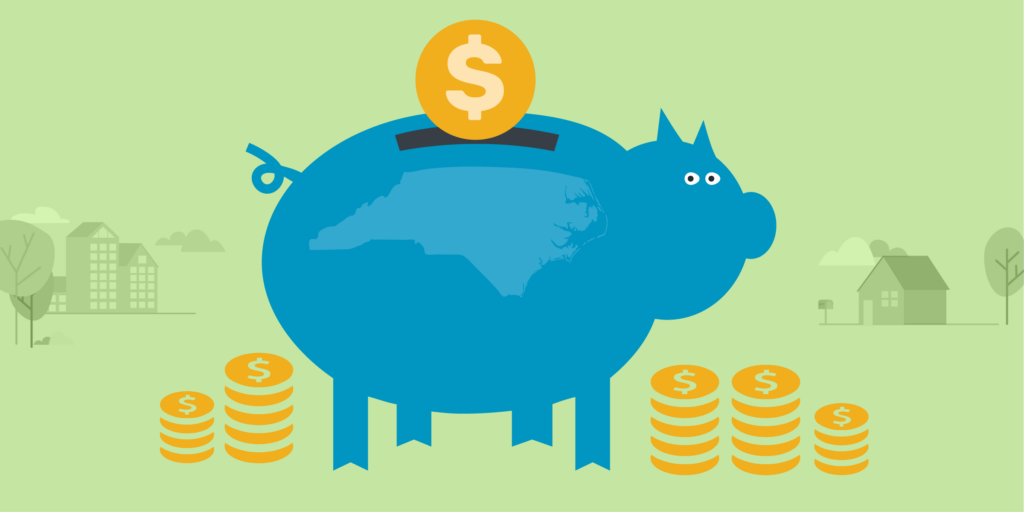
Beyond the Census data: How policy shapes well-being in NC
In September 2025, the US Census Bureau released annual data on poverty, income, and health insurance coverage for 2024. This resource will walk you through key data points for North Carolina and the public policy choices that influence these outcomes.
Poverty
How high is the poverty rate in North Carolina?
New data from the U.S. Census Bureau show that 12.5 percent of North Carolinians were living in poverty in 2024, showing no significant change since 2023. This means more than 1.3 million North Carolinians struggled to make ends meet on less than about $32,000 a year for a family of four. This poverty rate is the 17th highest in the country.
The child poverty rate is even higher than overall poverty, at 16.2 percent. This means that over 374,000 children in North Carolina lived in poverty in 2024, which is the 15th highest rate in the country. Child poverty rates are regularly higher than the overall poverty rate due to a combination of factors, including the high costs of raising children, a lack of work policies supporting employees who are caregivers, and relatively low levels of public spending on children relative to adults and the elderly.
As the chart below shows, poverty is most prevalent among the very youngest children, and rates were also higher among Latine, Black, American Indian, and multiracial North Carolinians than for Asian and white North Carolinians.[1] Racial inequality remains a persistent problem tied to current and historical discrimination and systemic racism that create barriers to secure employment, wealth-building, and economic opportunity.
How has the poverty rate changed over time?
The chart below shows that North Carolina has experienced double-digit poverty rates for decades. Following the Great Recession, as families lost income and elected leaders did too little to stabilize household finances, 1 in 4 children lived in poverty in our state. Poverty declined as the economy recovered and the comparatively robust response from the federal government to stabilize the economy meant that the short-lived recession caused by the public health crisis didn’t lead to an increase in the official poverty rate. (For more on how COVID-relief in the form of tax credits — which aren’t captured in the official poverty rate — tackled poverty, see below on the Supplemental Poverty Measure.)
With the exception of Virginia — whose residents experience both lower levels of poverty and smaller fluctuation in poverty rates — changes in North Carolina’s poverty rate and child poverty rate have largely mirrored neighboring states. This is likely because overall economic conditions are generally comparable across neighboring states to the south and west, while Virginia has significantly higher average incomes. Notably, only Virginia has raised its minimum wage above the federal minimum of $7.25 an hour. (Virginia’s minimum wage is $12.41 in 2025 and is increased annually based on inflation — in 2026 it will rise to $12.77.)
How can our state budget reduce poverty in NC?
Experience has taught us that poverty is not a fact of nature, but a choice that policymakers make when they decide how to spend our public dollars. We can see the impact of policy choices by looking at the Supplemental Poverty Measure (SPM), which the Census Bureau developed in 2009. The SPM differs from the OPM in several key ways, including[2]:
- it adjusts for geography to account for costs that vary depending on where people live
- it uses a more holistic measure of the cost of basic needs, and uses more recent data
- it incorporates the impact of non-cash benefits like food and housing assistance, and the cost of work and medical expenses
- it includes taxes, including tax credits
The SPM shows the powerful effect of supports enacted by the Biden administration as COVID relief, especially the expanded federal child tax credit in 2021. The chart below shows 3-year average poverty rates in North Carolina. It shows that over 2020, 2021, and 2022 the SPM was 10.3, compared to 13.3 when using the OPM. But with Congress failing to extend those policies, and only meager state supports for families with low incomes in North Carolina, there is no difference between the SPM and the OPM in the most recent data from 2022, 2023, and 2024 — both are at 14 percent.
The SPM shows us what is possible in North Carolina when our public dollars are invested in basic needs: When the federal government temporarily expanded the Child Tax Credit during the COVID-19 pandemic, child poverty in North Carolina plummeted by more than 40 percent in just one year. Analysis from Columbia University shows that if lawmakers in the General Assembly enacted their own Child Tax Credit worth up to $1,900 per child, child poverty would decrease by nearly one-third.[3] The SPM also tells us that crucial supports like Social Security, the Earned Income Tax Credit, the Child Tax Credit, and SNAP cut poverty rates almost in half in North Carolina: Without them, the SPM poverty rate would be 26.5 percent rather than 14 percent.
Income
What is the median income in NC?
Median household income was nearly $74,000 in 2024, which kept pace with inflation but showed no significant change from 2023 after adjusting for rising costs. (For comparison, a family of four in North Carolina needs an annual income over $97,000 to cover modest living expenses.) Median income in 2024 was lower than the statewide average for racial and ethnic groups who continue to face systemic barriers to economic security, including North Carolinians who identify as American Indian ($52,400), Black ($54,576), and Latine ($63,070).
How has income and income inequality changed over time?
Income inequality has increased in North Carolina. In 2010, the richest 5 percent had an average income 26 times greater than the poorest 20 percent. By 2024, average incomes for the richest were 29 times greater than those of the poorest. From 2023 to 2024, North Carolina was the only state to experience a statistically significant increase in income inequality.
How can our state budget boost incomes in NC?
Lawmakers have many opportunities to boost low incomes and build an economy that works for everyone through our state budget. In addition to enacting state tax credits, they can provide meaningful raises for teachers and other state employees. They can also increase funding for child-care subsidies, which helps providers pay child-care workers fairly and ensures that parents of young children can work. Policymakers can afford to make these investments if they stop future tax cuts for corporations and the richest North Carolinians. Finally, the General Assembly can pass legislation that raises the state minimum wage to $18 an hour and eliminates the tipped minimum wage, which would raise pay for 1 in 4 workers in our state.[4]
Health Insurance
What is the uninsured rate in NC and how has it changed over time?
The chart below shows that the share of North Carolinians without health insurance was 8.6 percent in 2024, down from 9.2 percent in 2023. Medicaid expansion, which went into effect in December 2023, played a major role in reducing the share of North Carolinians without health insurance in the last year. That decrease ran counter to the national trend, where the unwinding of pandemic-related Medicaid policies led to an increase in uninsured people.
How can our state budget increase health insurance coverage?
North Carolina’s progress in health insurance coverage is at risk due to massive Medicaid cuts in the Republican megabill passed by Congress in July 2025, and their failure to extend enhanced premium tax credits that make it possible for people to afford coverage through the Affordable Care Act marketplace. Cuts in that bill mean that an estimated 515,000 people in our state are at risk of losing health coverage.
At the state level, lawmakers have provided less state funding than the Medicaid program requires to maintain current reimbursement rates, which could lead providers to stop accepting Medicaid patients.
To protect the progress that North Carolina has made, state lawmakers must fully fund the state’s Medicaid contribution and take action to minimize the harm of federal cuts. This won’t be possible without adequate revenue, which means lawmakers must pause scheduled personal and corporate incomes tax cuts instead of charging ahead with cuts that mostly benefit corporations and the wealthy.
[1] We don’t include data on Native Hawaiian and Pacific Islanders because the small population numbers for this group mean the estimates have very high margins of error.
[2] Learn more about how poverty is measured: https://povertycenter.columbia.edu/poverty-measurement
[3] Other investments and policy choices — like paid family leave, higher minimum wages, affordable child care, subsidized employment, affordable housing, and transportation — can work alongside targeted tax credits to reduce the cost of raising children and connect North Carolinians to family-sustaining jobs.
[4] These 1 in 4 workers include workers whose current wage is less than the new minimum, as well as workers whose current wage is equal to or slightly higher than the new minimum, and whose wages are likely to increase because of the new law.





